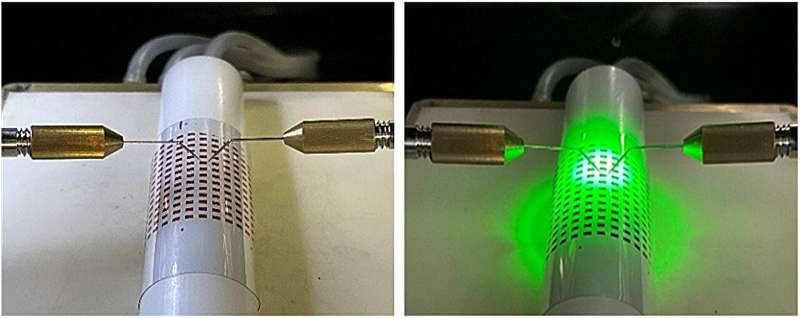Flexible optoelectronic device with minimal defects fabricated at just 90°C
Dr. Jung-Dae Kwon’s research team at the Energy & Environmental Materials Research Division of the Korea Institute of Materials Science (KIMS) has successfully developed an amorphous silicon optoelectronic device with minimal defects, even using a low-temperature process at 90°C. The findings are published in the journal Advanced Science.
Notably, the team overcame the limitations of high-temperature processing by precisely controlling the hydrogen dilution ratio—the ratio of hydrogen to silane (SiH4) gas—enabling the fabrication of high-performance flexible optoelectronic devices (sensors that detect light and convert it into electrical signals).
Flexible optoelectronic devices are key components of next-generation electronic devices, such as wearable electronics and image sensors, and require the precise deposition of thin films on thin, bendable substrates. However, a major limitation has been the necessity of high-temperature processing above 250°C, making it difficult to apply these devices to heat-sensitive flexible substrates.
To overcome this limitation, the research team employed precise control of the hydrogen dilution ratio using mass flow controllers during the plasma-enhanced chemical vapor deposition (PECVD) process, which is commonly used for thin-film device fabrication. This approach enabled uniform thin-film quality even at low temperatures.
In addition, by applying hydrogen passivation, they enhanced the electrical performance of the material while minimizing thin-film defects. As a result, they succeeded in fabricating a flexible optoelectronic device that maintained its performance while reducing the processing temperature by more than 60% compared to conventional methods. This substantial reduction in thermal budget also contributes to lowering overall production costs.

This technology utilizes photoresist (PR) as a sacrificial layer to enable the clean and precise formation of active areas in optoelectronic devices. Photoresist allows stable thin-film deposition even on heat-sensitive flexible substrates and can be easily removed through a simple process, thereby streamlining and improving the efficiency of the entire fabrication process. One of the key advantages of this research outcome is the ability to reliably produce high-quality optoelectronic devices without the need for complex plasma etching processes.
Using this technology, the research team achieved a high photosensitivity—approximately 96% of that of conventional high-temperature processed devices.
Furthermore, after conducting over 2,700 bending tests at a 5 mm bending radius, the device demonstrated excellent mechanical durability and stability with no performance degradation. As a result, this technology is expected to be widely applicable in the fabrication of wearable and flexible electronic devices.
Dr. Jung-Dae Kwon, the principal investigator at KIMS, stated, “This technology demonstrates the potential to fabricate high-quality thin films and high-performance optoelectronic devices without high-temperature processing, simply by precisely controlling the hydrogen dilution ratio.
“We expect this advancement will enable the development of cost-effective and high-performance flexible optoelectronic devices across various applications, including wearable electronics, image sensors, and optical sensors.”
More information:
Ye‐ji Jeong et al, Tailoring Hydrogenation to Enhance Defect Suppression and Charge Transport in Hydrogenated Amorphous Silicon for Flexible Photodetectors, Advanced Science (2025). DOI: 10.1002/advs.202504199
National Research Council of Science and Technology
Citation:
Flexible optoelectronic device with minimal defects fabricated at just 90°C (2025, August 1)
retrieved 2 August 2025
from https://techxplore.com/news/2025-08-flexible-optoelectronic-device-minimal-defects.html
This document is subject to copyright. Apart from any fair dealing for the purpose of private study or research, no
part may be reproduced without the written permission. The content is provided for information purposes only.

Comments are closed